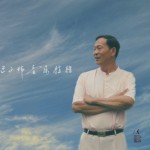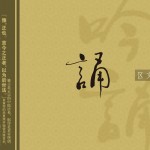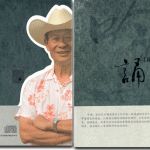Introduction
By Robert A. Anderson
How to describe The Path of Life? Not an easy task, but here goes: The Path of Life is, simply and generally, a book in three parts about the past, present, and future of the universe—including the past, present, and future of humanity. That’s all.
Actually, that’s not all: there’s a lot more to it than that. When I first read The Path of Life—the very rough English translation that I have now spent years (with much help from others) transforming into its present state—I expected a book strongly flavored by Taoism and Chinese Buddhism, subjects I have read widely about in the past forty years. Although there are many elements of Chinese culture, mythology, and religion in it, I found myself immersed in a story I kept thinking of as Biblical.
The Path of Life begins with its author, Ou Wen Wei, now a well-known and highly respected qigong master and healer, author and calligrapher, then (1974) a young man with a wife and baby daughter, receiving communications from a supernatural entity later identified as Pangu, who, in Chinese mythology, is the Creator of the universe—or, in another word, God. But the book is not simply a Chinese version of a “conversation with God”; it is instead more like a struggle with God—a wrestling match, as it were, with Master Ou sometimes playing the role of Jacob and at other times that of the victim shown no mercy: Job.
There are, in a way, two separate plots to The Path of Life—although Pangu eventually reveals to Master Ou (and to us) how they are linked. First is the developing relationship between Pangu and Master Ou, in which Pangu tells him that he has been chosen to lead humanity into its new and final stage of development: the future world. Here we get Biblical again: Master Ou, Moses-like, repeatedly protests this choice, saying, “It shouldn’t be me,” that he is not capable enough, not eloquent enough, is, in fact, too “ordinary.” “But that’s exactly why you’ve been chosen,” Pangu in effect tells him, “the role calls for an ordinary person!”
Meanwhile Pangu is revealing to Master Ou what the universe is all about: how it began, how it got to its present state, where it is going. Pangu does this, appropriately enough for our time, in a cinematic way: by showing Master Ou scenes in his mind (think Secrets of the Universe: the Movie), scenes he cannot help but view whether he wants to or not, whether his eyes are open or closed, whether he is alone or with others.
These “others” are, for the most part, his jailers and accusers: his tormentors—which brings us to the other plot of The Path of Life. Very early in the book Master Ou is suddenly taken prisoner. It is, after all, 1974: the Great Proletarian Cultural Revolution is still going on, and, like millions of others, he is arrested on false and/or exaggerated charges by the latest political faction that happens to be in power in his part of Guangdong Province (Canton). The leaders of this faction try to make him confess to his “crimes” in interrogations and public gatherings; when he is not being interrogated or publicly humiliated, he is forced to do “hard labor”—road construction.
So there is double suspense: what will happen to him—and his wife and baby—if he continues to defy his captors? But if he gives in to them, then what happens? Millions were executed during the Cultural Revolution; many more committed suicide (as did his father-in-law, a Christian—Master Ou’s personal history is part of the plot too, including his poignant, long-distance courtship with his wife, Mandy).
But also: how will his struggle with this supernatural entity claiming to be Pangu turn out? At times it gets very, very nasty: I mean, telling the Creator of the universe to go f— himself? But how can he be talking to him in the first place—talking to someone who doesn’t exist? This is the basic dilemma for the young Ou Wen Wei, a thoroughgoing materialist—indeed, a dialectical materialist—for, according to materialism, the supernatural does not exist. In fact, much of their arguing is over this very issue: Master Ou’s refusal to recognize the other’s existence. But how can he not recognize it? He is talking to it! Not only that, he is controlled by it: in an effort to win their “argument,” Pangu continually demonstrates his control—and therefore his existence—in various ways: by levitating Master Ou’s body, by causing an out-of-body experience, by paralyzing him, by making him so sick with diarrhea that he shits dozens of times in one night (only to be physically fine the next morning). And not only that: eventually we (and Master Ou) are told that Master Ou is Pangu…or soon will be. Still Master Ou resists him—or tries to.
And meanwhile…through the descriptions in the text we see what he is seeing in the cinema of his mind: civilizations—worlds—created and destroyed, over and over. We learn the meanings of things: why we can’t remember the earliest period of our lives, why pi has no end, why evil exists, at what point the fetus is endowed with a soul, what happens to the soul after death, which is better, socialism or capitalism, will there ever be a classless society, what sex will be like in the future world, why there are so many religions, is the theory of evolution true or not?…
What are we to make of all this? Are we to believe it? Or, like the young Ou Wen Wei, do we try to deny it? Pangu has the answer: make of it what you will: it is not necessary to believe it as fact, as revelation; think of it as myth, legend, science fiction—a good yarn with classic martial-arts battles (including one pitting Monkey King against the Jade Emperor). What is important is to pay attention to the message. And Pangu’s message is very simple: shape up. Here we get back to The Bible again—but now to the New Testament: rather like Jesus, Pangu is a simplifier; his teaching is basic, having to do with kindness and benevolence, how we treat others—a message that eventually became the foundation for the highly effective healing exercise Master Ou subsequently developed: Pan Gu Mystical Qigong, now practiced by tens and tens of thousands in China, the United States, and around the world.
*
It was at one of his qigong classes that I first met Master Ou, more than fifteen years ago. A friend of mine—a fellow taiji quan practitioner—called and said that a teacher of hers was going to be giving a workshop at her house outside of New Bedford, Mass.—where my wife and I were then living—on an upcoming Sunday morning—was I interested in attending? I answered with a polite waffle. Certainly a part of me was, the part that is always interested in such a workshop, but there were the usual inner arguments against going: couldn’t afford it, had something else to do, was it really going to be worth my while? Besides, as I told my friend, my wife and I were at that time attending a three-month, once-a-week medical qigong course given by a respected teacher of both taiji quan and qigong. That may be, she rejoined, but this class will change your life.
Speaking to us through an interpreter, Master Ou began by telling us of his past contact with this supernatural being he called Pangu—not what I had expected in a qigong workshop. When he did get to teaching the actual exercise, it turned out to be rather simple in its mechanics: a series of circling motions made with the hands. What we were doing by making these circles, he explained, was capturing the energy of the sun in one set of rotations, the energy of the moon in another set, then combining these two energies in a third set. There was also an arm stretch in which we opened ourselves up to and then “embraced” the universe, and a briefly held posture in which we imagined our cupped palms “holding the golden chrysanthemum” (symbol of the future world, I later learned). At the beginning and at the end of the exercise we were to recite some phrases pertaining to what this supernatural being had told him about how we should conduct ourselves—with “kindness and benevolence” among other admirable qualities.
Although very different from any other qigong I had learned, I found myself receptive to it. The idea of an exercise—a ritual—grounded in myth—the figure of Pangu—especially appealed to me. Over the years mythology has become for me, a writer of fiction, more and more a field for the exploration of reality. Another attraction lay in its feature of inner alchemy: absorbing and then synthesizing the energies of the “golden sun” and “silver moon.” I left the workshop thinking, and saying to my wife, that this Pan Gu Mystical Qigong might be just what I had been looking for.
What happened next was that my wife and I began to practice the exercise on a daily basis. And what happened after that was that we both began “feeling things.” Among practitioners of qigong and taiji quan these are referred to as “qi sensations.” In my case it was strong tingling in my hands, like electric currents, curling my fingers; also heat. Then I began having these experiences when I wasn’t practicing the exercise. What is qi? you might ask. It is energy, the energy that animates the universe, that is in all of us, whether we consciously feel it or not; the energy that acupuncturists manipulate by using needles. I had had qi sensations before, but what I was experiencing now was new to me.
But there was something else going on as well, something more subtle and also more important: I began to feel better. That is the best and most concise way I can put it. Emotionally, psychologically, psychically, spiritually—I’m not sure which of those words or combinations thereof would be most accurate; perhaps all of them apply. Does it matter? My wife reported feeling better too. Perhaps in her case what was happening can be described more specifically: she had been experiencing some tough times, emotionally and physically, due principally to her brother’s illness and death and to past injuries sustained during her dance career; menopause amplified the depression and pain. She says that she doesn’t know what would have happened to her if she hadn’t learned Pangu qigong when she did.
It was at a follow-up class with Master Ou in the Boston area—with Vincent Chu interpreting, one of Master Ou’s senior students in the United States and also one of the foremost taiji quan teachers in the world—that I learned of the existence of The Path of Life and Master Ou’s wish to make it available in a decent English translation. Immediately I volunteered to help and have worked on it—on and off, initially with Vincent’s invaluable assistance, later with that of Master Ou’s daughter, Olivia Ou—ever since. That work, along with the exercise that arose out of it, has indeed, as my fellow Pan Gu Mystical Qigong practitioner Mary Beth Soares once predicted, changed my life.
*
As for what I make of The Path of Life, I must admit it is my kind of book, presenting as it does mythology as reality (or reality as mythology): the creation of the universe, past conflicts between heaven and earth, interpretations of present-day events and people, the torturous self-sacrifice of the Creator himself and his subsequent resurrection, a fantastic future world (including an earth that is no longer a sphere). Plus at its most basic level it is the story of one man caught up in two nets at the same time. How could I not like a book that informs me, “truth originates from absurdity”?
Whatever a reader might make of The Path of Life, I know what I have made of Master Ou, Qigong master and healer and my former adversary in war: a very good friend. I have been a guest in his house, eaten at his table with his wife and daughter (also my friends), experienced the energy that comes out of his healing hands, traveled to China with him, met students—many—who have recovered from very serious illnesses through the practice of his qigong, and even, during the Tet holiday of 2012, revisited the country where we were once enemies—where we continued our gestures of mutual respect. I have listened to him speak many times openly, honestly, and emotionally of his experiences, of his hopes for others, of his faults, of his accomplishments, of his admiration and respect for the United States and its precious freedom of religion. He is in some ways an ordinary person, a “good guy,” priding himself on his rendition—in English—of “You Are My Sunshine”; in other ways he is quite remarkable, in fact, the most remarkable human being I have ever met (and a very good cook, too).
*
Near the end of The Path of Life Master Ou tells us of his overriding wish: to tell others of his experience. In his Preface we learn what happened concerning that wish: for over ten years he was unable to write about it. Not because of lack of time, not because of state censorship; he tried—in fact, he tried every night—but the hand holding his writing brush would not move. Until one night when something very different happened: his writing hand indeed moved, but not under Master Ou’s control: it moved by itself. And having moved, it moved on. Thus his tale was told.
In helping to make this remarkable story available to readers of English, I am humbled, I am honored, and I am hopeful that those readers will recognize the invaluable treasure that it contains.
(Robert A. Anderson is a novelist, playwright, and editor. His novels Cooks & Bakers and Service for the Dead were both set in the Vietnam War. He is the co-author of The Cat, the Sun, and the Mirror, an illustrated story based on an ancient Japanese myth.)




 Mr. Xue
Mr. Xue




 Paul Fraser
Paul Fraser